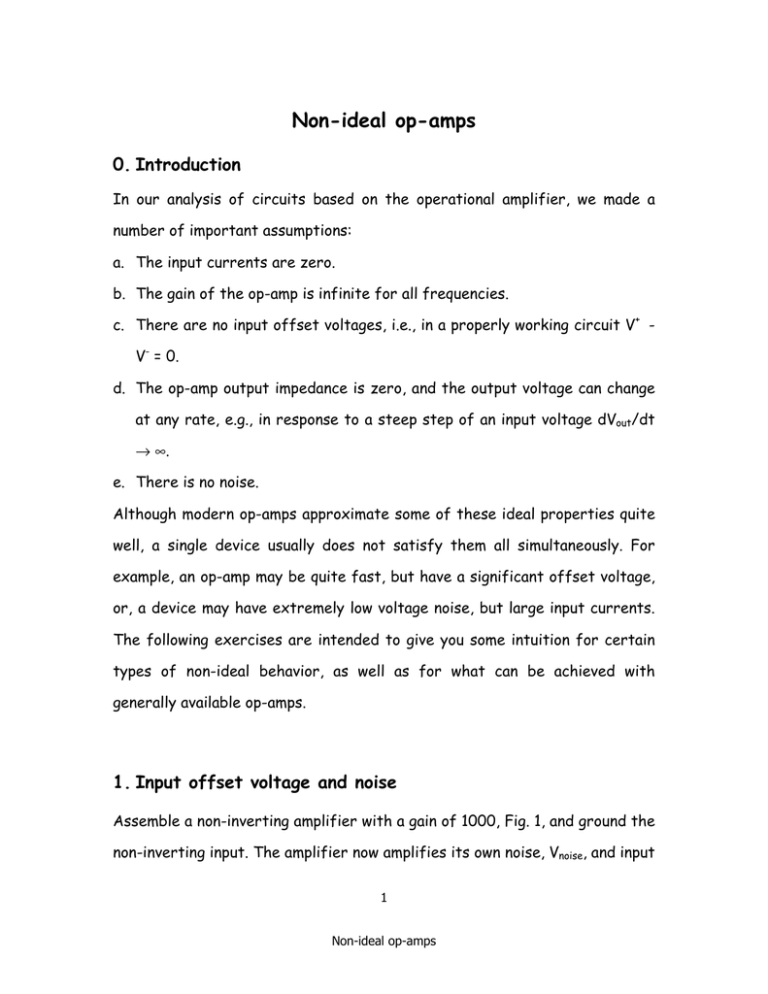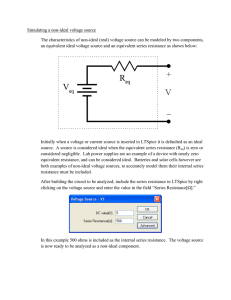Non-ideal op-amps
advertisement

Non-ideal op-amps 0. Introduction In our analysis of circuits based on the operational amplifier, we made a number of important assumptions: a. The input currents are zero. b. The gain of the op-amp is infinite for all frequencies. c. There are no input offset voltages, i.e., in a properly working circuit V+ V- = 0. d. The op-amp output impedance is zero, and the output voltage can change at any rate, e.g., in response to a steep step of an input voltage dVout/dt → ∞. e. There is no noise. Although modern op-amps approximate some of these ideal properties quite well, a single device usually does not satisfy them all simultaneously. For example, an op-amp may be quite fast, but have a significant offset voltage, or, a device may have extremely low voltage noise, but large input currents. The following exercises are intended to give you some intuition for certain types of non-ideal behavior, as well as for what can be achieved with generally available op-amps. 1. Input offset voltage and noise Assemble a non-inverting amplifier with a gain of 1000, Fig. 1, and ground the non-inverting input. The amplifier now amplifies its own noise, Vnoise, and input 1 Non-ideal op-amps offset voltage, Vo. Measure Vo using your DMM, and with the help of an oscilloscope, estimate Vnoise. Do this for three different op-amps, the LM741, OP27 and LT1792. Note not only the difference in magnitude of the noise but also its spectral characteristics. Figure 1. Offset and noise 2. Input currents To measure the input current you can connect a resistor, Rin, between the non-inverting input and ground. The current into the input causes a voltage drop across Rin, which is amplified in the same way as Vo. The input current, Ibias is given by Ibias = ∆Vout/(1000×Rin), where ∆Vout is the difference in the output voltage with Rin shorted or not shorted. Op-amps with FET inputs have an Ibias that is so small that this method becomes less practical. 2 Non-ideal op-amps Instead of measuring the voltage drop across a resistor, one can monitor the change in voltage across a capacitor as it is charged by the bias current. In this case Ibias = C×(∆Vout/1000)/∆t, with ∆Vout the change in the output voltage over the measuring time ∆t. Determine the input bias currents for the LM741, OP27 and LT1792. Figure 2a. Determining the bias current for the LM741 and OP27 Figure 2b. Determining the bias current for the LT1792 3 Non-ideal op-amps 3. Gain-bandwidth product A convenient number to characterize an op-amp is its gain-bandwidth product. It tells you directly which bandwidth can be realized for which closed loop gain. To look at this, determine the small signal frequency response for non-inverting amplifiers with gains of 10, 100 and 1000, based on the OP27. What do you obtain for the gain-bandwidth product? 4. Transient response and slew rate The transient response, i.e., the response to a step or pulse, of an amplifier is determined by the frequency response of the op-amp, as well as that of the feedback loop. With amplifiers configured for a high closed loop gain, one will primarily see the effect of the limited over all bandwidth. The response to a step will have an exponential shape with a rise time τ = 1/2πfc (fc is the 3dB bandwidth). With low gain amplifiers the details of the feedback circuit become important, as well as the behavior of the op-amp at high frequency. Stray capacitance can cause phase shifts that make the circuit unstable. First, construct an amplifier with a gain of +2 (Fig 3). Apply a square wave, 100 kHz, 100 mV signal to the input and compare input and output signals. Do this for the LM741 and the LT1792. The oscillations observed with the LT1792 can be eliminated with a small capacitor parallel to the feedback resistor 4 Non-ideal op-amps Figure 3. A circuit to determine the transient response Secondly, increase the gain of the amplifier to 10, and again compare the behavior of the circuit with an LM741 and an LT1792. It should be clear that while the LT1792 can follow the input signal with ease, the LM741 is now too slow. Finally, still with an amplifier gain of ten, look at what happens when the signal amplitude is increased. For small amplitude, you should observe a well defined, amplitude independent, rise time for the LM741. When the input voltage exceeds 200 mV the character of the output voltage starts to change. It now appears that the voltage can only change at a fixed rate, independent of the amplitude at the input. This rate is called the slew rate. Try to repeat this with the LT1792. Only very close to the point where the output gets completely saturated will you see deviation from “ideal” behavior. 5 Non-ideal op-amps





